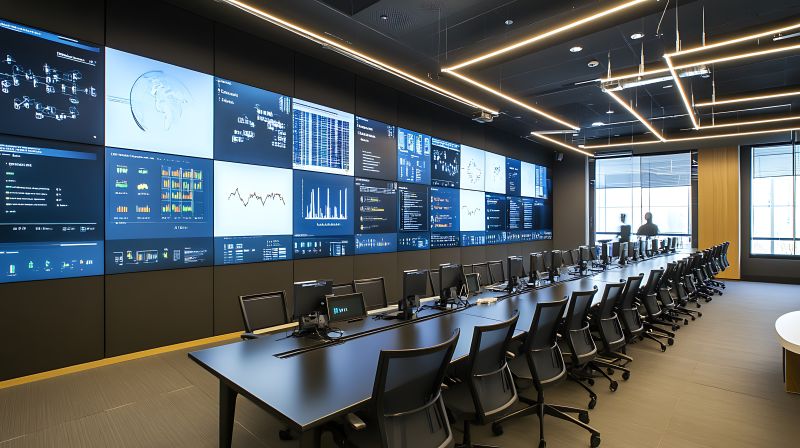In today’s highly connected world — with more than 21 billion internet-of-things (IoT) devices expected to be online this year — more organizations are using command and control centers to monitor, manage and protect critical operations to enhance awareness across a facility or geography. This is helping drive the market’s value from $31.5 billion in 2023 to $57.6 billion in 2033, and in the process creating significant opportunity for system integrators.
The market opportunity for integrators is growing. However, the planning, designing and equipping of always-on command and control centers requires a lot of consideration and, in some instances, a new set of skills. Integrators that understand how to meet the needs of the command and control end user, along with the different command and control operations and technologies, can position themselves as front-runners to capture a share of this thriving market.
Today’s Diverse Command & Control Needs
Command and control centers are no longer just specialized environments used in select sectors like information technology and public safety. They’ve become mission-critical hubs for a myriad of operations and have become accessible to a broad range of organizations.
This has been driven by trends like network- and connected device-convergence as well as product convergence in the tech space. Furthermore, IT and operational technology (OT) convergence allows centralized monitoring, control, data aggregation and data-driven actionable insights. The surge in data generation and storage also created a need for increased operational efficiency and a robust monitoring and management infrastructure within the corporate and other like environments.
Main Verticals
Command and control centers are vital in industries such as:
- Data centers: Maintaining uptime and ensuring smooth operation across various data center types, including commercial, multi-tenant, hyperscale and enterprise facilities.
- Commercial and corporate campuses: Managing building operations, security systems, energy consumption and other critical functions.
- Critical infrastructure: Monitoring and managing critical systems in utilities, renewable energy sources like wind and solar, and telecommunications networks.
- Transportation: Overseeing traffic management, fleet operations and security systems.
- Universities and educational institutions: Enhancing safety and security, monitoring building systems and managing network operations.
- Public safety & security: Surveillance systems for police, fire, ambulance and natural disasters
NOCs and SOCs
Two commonly found C&C centers are network operations centers (NOCs) and security operations centers (SOCs). NOCs focus on monitoring and managing network infrastructure and performance. SOCs focus on safeguarding systems and data from cyber threats and intrusions and are vital in monitoring and managing infrastructure.
A NOC or SOC typically consists of a dedicated room that serves as the nerve center for monitoring and managing operations. These centers use specialized software and tools to provide real-time visibility and enable control over systems.
How Integrators Enhance Command & Control Centers
Some key aspects of these rooms where integrators can make an impact include:
Audiovisual Systems
Visualization and communication via audio and video surveillance are essential for detecting and responding to incidents promptly. Video elements should be thoughtfully deployed to operators’ needs. For example, videowalls can give all operators a high-level view of operations or infrastructure, while desktop monitors allow individual operators to focus on specific areas of concern or interest. Conducting sightline testing can help verify that operators can see each of these screens.
Data Management and Delivery
The right data strategy in a command and control center enables more proactive responses to issues and the optimization of building operations. Additionally, the volume of data produced by building systems and IoT devices continues to grow, and C&C centers need to collect and make sense of the data and empower operators to act on it.
C&C operations are turning to technologies like central intelligence management platforms that centralize disparate building systems, IoT devices and platforms, aggregate their data and convert it into operational intelligence. This helps command and control staff efficiently and accurately control building operations, understand real-time energy usage, schedule maintenance and share reports.
Ergonomics
Ergonomics impact performance, making it a key design requirement in command and control centers. Chairs and tables should be ergonomically designed and deployed to support maximum comfort and mobility for command and control work that can be hectic and last for long stretches of time. Sit-to-stand capabilities like stand-up desks have become essential.
Lighting and Acoustic Room Treatment
Lighting and acoustics are critical to the performance and well-being of command and control operators. For instance, lighting should be soft, uniform and calming — avoiding glare or harsh contrasts that can cause fatigue during extended shifts. The room also should be acoustically neutral to minimize echo and ambient noise, ensuring clear communication and reducing cognitive load.
Acoustic panels, sound-absorbing materials and thoughtful layout contribute to a quieter, more focused environment where operators can remain attentive and effective over long periods.
Final Thoughts
With the right approach, integrators can maximize operational efficiency and establish themselves as trusted partners for deploying resilient, reliable and state-of-the-art command and control centers for this rapidly growing sector.
Phil Langley is vice president and general manager, global enterprise audio visual, at Wesco.




